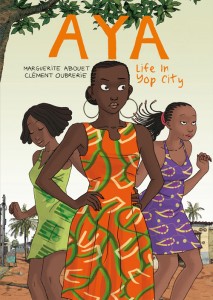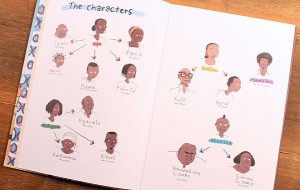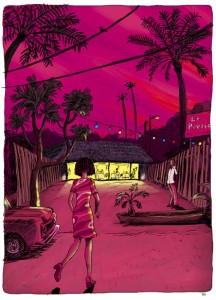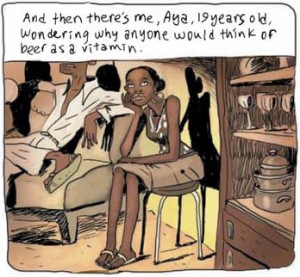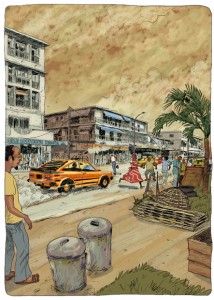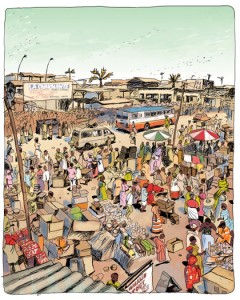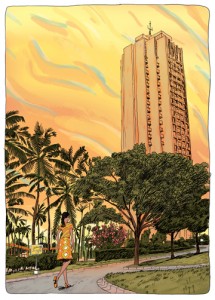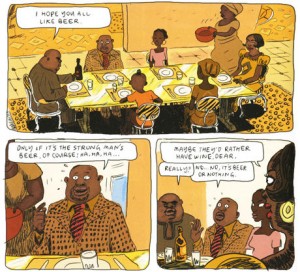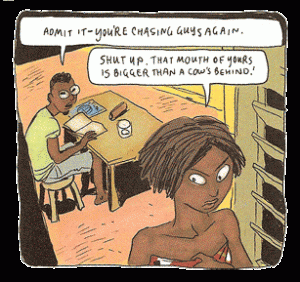Welcome to Using Graphic Novels in Education, an ongoing feature from CBLDF that is designed to allay confusion around the content of graphic novels and to help parents and teachers raise readers. In this column, we examine graphic novels, including those that have been targeted by censors, and provide teaching and discussion suggestions for the use of such books in classrooms.
In this post, we explore Aya: Life in Yop City by Marguerite Abouet and Clement Oubrerie’s (Drawn & Quarterly). Aya: Life in Yop City is a novel that is loosely based on Abouet’s life and centers around 19-year old Aya, her friends, and their families in the Ivory Coast working class suburb of Abidjan in the 1970s.
Aya was the winner of the Best First Album award at the Angouleme International Comics Festival, the Children’s Africana Book Award, and the Glyph Award. It was also nominated for the Quill Award, YALSA’s Great Graphic Novels, and the Eisner Award. It has also been included on best of lists from The Washington Post, Booklist, Publishers Weekly, and School Library Journal. It has been adapted into a film, Aya of Yop City (produced by Joann Sfar and Antoine Delesvaux).
Table of Contents
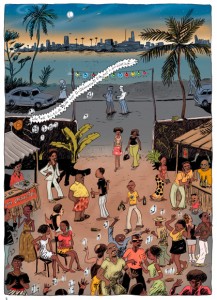
OVERVIEW
Aya of Yop City takes place in Yopougon-Koute, or Yop City for short. Côte d’Ivoire, a country on the west coast of Africa, was colonized by France and considered a French colony until August 7, 1960, when the country achieved its independence. While there is a wonderful preface introducing the politics and history of the Ivory Coast in the 1970s and an “Ivorian Bonus” in the back of the book that features a glossary, recipes, and instructions to wrap fabric for skirts, a hat, and baby carrier, the book is more about the story’s particular characters and the personal / social challenges they face. It is also an exploration of class and gender politics of 1970s Abidjan.
The reader is a passive observer of the actions as they unfold, the subplot stories of the various characters are told through limited narrative full of slang and Ivorian references along with bright colorful images, giving the story a very real and local feel. Aya balances the nostalgic power of the Ivory Coast in the 1970s with the personal drives, aspirations, and habits of its characters.
This is a book for mature teens, as it deals with college dreams, teenage pregnancies, and infidelities. It weaves stories of female objectification and of class differences in the small working class suburb. While mature content may cause some concern, this book provides a fascinating look at a different culture, in which diversity was frowned upon and women and men had distinct roles, and an era during which women began to hope for more.
Aya: Life in Yop City themes include:
- The tugs of friendship as Aya, Benton, and Adjoua find themselves wanting and expecting different things from their lives. While Aya wants to break stereotypes and go to medical school, Adjoua finds herself pregnant and faces life as a single mother, and Bintou hopes to find a rich Frenchman to take her away from the quiet life of Abidjan to the more fashionable and exciting life of Paris;
- The status of women in the Ivory Coast and the challenges the young women face in their quest to advance their lot and roles;
- The struggles of men to preserve their roles as women strive for greater rights and freedoms;
- The importance and frailties of loyalty, friendship, family, and commitment;
- The role of class and gender in 1970 Abidjan;
- The challenges of dealing with unwanted pregnancies;
- The stresses and the comforts of strong families and small communities.
SUMMARY
In Aya: Life in Yop City, Marguerite Abouet and Cement Oubrerie weave various subplots that center round Aya. Aya, aged 19, is the oldest of a large family living in the working-class suburb of Abidjan on the Ivory Coast. She, unlike any of her friends, is a serious student who studies hard in the hope of doing well enough to get into medical school. Her two friends, Bintou and Adjoua, are more typical of Abidjan teens. They are resting their hopes for the future in finding a man, marrying, and raising a family. Bintou, in particular, has high hopes for snaring first Moussa, the son of a wealthy merchant, or a Frenchman who will take her to Paris. The social lives of Adjoua and Bintou are each their own subplot, as is the life of Aya’s parents, Adjoua’s brother Albert, and Bintou’s cousin Herve, who is living with them.
The cast of characters is somewhat large and it may take some time to keep everyone straight, but there is a very helpful chart of characters in the front of the books. As the book opens, we learn that it is summer holidays, and Bintou and Adjoua are intent of going to all the parties they can. They also frequent the Maquis, an inexpensive open-air restaurant with music and room to dance when open. Young adults also use the Maquis’ tables in the dark (and privacy) of late night once the Maquis is closed.
Early in the book, Adjoua finds out that she’s pregnant, and she believes Moussa (Bintou’s heartthrob) is the father. This causes a great deal of friction with Bintou, who must now find another love interest. As the story weaves its tales and subplots, the girls work at easing the tensions and hurts that the developing and intersecting love triangles create. In addition to the girls’ stories, a plot that involves Adjoua’s brother, who is in some relationship he tries to hide, is woven with a subplot involving the older men of the town, and there is a local beauty contest all the girls but Aya enter in the hopes of winning prizes that will help make their daily lives a bit easier.
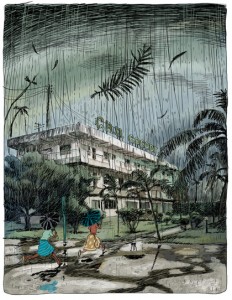
While the story focuses on Aya’s friends’ fretting over their boy-related problems and how to speak, walk, and dress for the beauty pageant, their various subplots are all couched in the social climbing tendencies of Bintou and of all of the girls’ parents. This illuminates this very distinct time period in African history. Before the soon-to-follow political and economic upheaval, Yop City in the 1970s was an exciting and hopeful time, an exception to the mostly negative changes occurring in Africa. This story reflects this hope.
We also learn that the women in Aya’s world continually ignore signs from men, constantly believing their lies and allowing themselves to be misled and hurt. It seems that Aya alone is searching for better answers. We learn about how difficult life in this suburb is for everyone and how each of the characters tries to make do.
Abouet’s story reads almost like a soap opera, with women chasing men and then being hurt, deceived, and abandoned, but Aya who takes no part in this. The planning, preening, and deceptions keep coming, making this book a fast read. Oubrerie’s vibrant and colorful images and Abouet’s slang and use of Ivorian jargon capture the look, feel, and sound of the Ivory Coast. Oubrerie’s use of sunlight and open bright skies (night and day) allows readers to feel that they are sitting at the table at the Maquis, right next to the action and observing the story unfold. Furthermore, Oubrerie’s use of color helps inform readers of subplots, changes, and flashbacks.
While the story is engaging, its richness lies in the art and in the depth of its characters. Moussa, the son of a wealthy merchant, lives with his domineering, over-nurturing mother and unsympathetic father in a large peachy-pink house that dramatically sticks out from all others. Then there is Herve, the only decent male character, who lacks any self-confidence and walks around hunched over throughout the book. The also includes Aya’s parents, Aya’s friends, and finally, Aya herself, who desperately works to forge a new path for herself and others. Aya shows her friends and her parents that the old way is not necessarily the best way.
DISCUSSION SUGGESTIONS
Plot, Theme, and Character Development
- Plot and discuss Bintou, Adjoua, and Aya’s goals. How might they be growing together or growing apart based on their different goals?
- Plot and chart each of the subplots. Evaluate what is told through prose and what is revealed through images in each of the subplots.
- Discuss how each of the characters stands out:
- Evaluate Aya’s character and how it must have felt to break stereotypes and how at 19 she was more interested in studying to be a doctor than going out with boys.
- Evaluate how difficult it was for Herve, who felt so different from the others.
- Evaluate the friendships between the three girls. How were they different? Why were they such good friends?
- Discuss how Aya and her mother were similar and different, especially when it came to dealing with Ignace and his infidelities.
Critical Reading and Making Inferences
- Discuss Abouet and Oubrerie’s use of metaphor and simile. For example:
- p. 17: “That mouth of yours is bigger than a cow’s behind… Look at that butt it is as flat as a pancake.”
- p. 205: This is like looking for a machete in a manioc field.”
- p. 218: “Men are like hospital beds, they’ll take anyone under their skirts.”
- p. 276: “Life is like a bench. If she shoves and you fall off, it’s over she’ll just take your place.”
- Discuss each of the parents’ roles in this story. Would you consider them good parents? Loving parents? Why or why?
- On page 15, Aya reflects on the beer commercial for Solibra and wonders, “Why anyone would think of beer as a vitamin.” Why might they? Do you think this is a productive angle for selling beer?
Language, Literature and Language Usage
- Search, find, and discuss the use of metaphor throughout the book.
- Search and discuss the use of slang, idiom, imagery, and humor. For example:
- p.17: “That mouth of yours is bigger than a cow’s behind.”
- p. 205: “This is like looking for a machete in a manioc field.”
- p. 218: “I guess the sun can shine on anybody.”
- p. 250: “Men are like hospital beds, they’ll take anyone under their sheets.”
- p. 276: “Life is like a bench. If she shoves and you fall off, it’s over she’ll just take your place.”
- p. 296: “You don’t know a bricklayer ‘til you’re up against the wall.”
- p. 300: “Yes. Well. Mother Nature isn’t always the nicest person in the world…”
Cultural Diversity, Civic Responsibilities, History, and Social Issues
- The book opens with a shot of a television showing an image of an advertisement for Solibra, a popular local beer. Compare and contrast this image and commercial description to what a television and commercial image in your city in 1978 might have looked like. Are they similar/different? Why?
- There are many cultural references to the 1970s. Have students search for those references and research/explain their significance. For example (these are just a few, there are many):
- p. 100: References to Steve Austin (referring to the Six Million Dollar Man) and Catherine Deneuve;
- p. 122: a reference to Julio Iglesias;
- p. 141: mention of Bobby from the television show Dallas.
- Discuss the roles of Ivorian men and women in the 1970s, citing specific examples from the text. How (if at all) were they different to the roles men and women assumed in the United States and/or in France at that time?
- Discuss the role French culture played on Ivory Coast. For example, Parisian styles are frequently mentioned as is that fact that young men and women often go to Paris to seek their fortunes, but many come back.
- The Ivory Coast was a French colony. Research various African colonies (or Caribbean colonies) and how the colonizing country influenced their culture.
Modes of Storytelling and Visual Literacy
- Discuss and evaluate Oubrerie’s use of color and changing color palates throughout the book.
- In some instances, instead of using multiple colors, there are spreads where a single color dominates the images (for example: on pp. 13-14 sepia tones dominate; on pp. 64-65 dark blues dominate; on pp. 68-69 red dominates, on pp. 78-79 purple dominates, etc.). Discuss why some pages are multicolored and others are drawn heavily in single colors.
- Discuss how Oubrerie uses color and panel design to illustrate flashbacks. Discuss how effective his method is.
Paired Reading Suggestions
- Aya: Love in Yop City by Marguerite Abouet and Clement Oubrerie comprises the three final chapters of the Aya story.
- Akissi by Marguerite Abouet (translated from French by J Taboy) and illustrated by Mathieu Asapin is about a younger girl, her family, and life in the Ivory Coast.
- The Dark Child: The Autobiography of an African Boy by Camara Laye (for mature readers) is a memoir of Camara Laye’s youth in the village of Koroussa, French Guinea.
- My First Coup D’Etat and Other True Stories from the Lost Decades of Africa by John Dramani Mahama (for mature readers) chronicles the coming-of-age of John Dramani Mahama in Ghana.
- A Daughter’s Legacy by Pamphilia Hlapa (for mature readers) is the story of Kedibone’s journey from childhood to parenthood as she moves from the her home village to the more modern university and then working life, all in a world of taboos and abuse that the male-dominated culture allows.
COMMON CORE STATE STANDARDS (CCSS)
As the content of this book is recommended for mature teens, grades 10+, its classroom use becomes more challenging. As noted in the introduction, however, there are no doubt, classrooms that will be well served with the content, language and structure of this story, as well as its glimpse at life in the 1970s Ivory Coast. In discussing how this book meets CCSS, I will be using the Common Core Anchor Standards for College and Career Readiness for Reading, Writing, and Speaking and Listening to help guide interested educators:
- Knowledge of Language: Apply knowledge of language to understand how language functions in different contexts, to make effective choices for meaning or style, to comprehend more fully when reading or listening.
- Vocabulary Acquisition and Use: Determine or clarify the meaning of unknown and multiple-meaning words and phrases by using context clues, analyzing meaningful word parts, and consulting general and specialized reference materials; demonstrate understanding of figurative language, word relationships, and nuances in word meaning; acquire and use accurately a range of general academic and domain-specific words and phrases sufficient for reading, writing, speaking and listening at the college and career readiness level.
- Key ideas and details: Reading closely to determine what the texts says explicitly and making logical inferences from it; citing specific textual evidence when writing or speaking to support conclusions drawn from the text; determining central ideas or themes and analyzing their development; summarizing the key supporting details and ideas; analyzing how and why individuals, events, or ideas develop and interact over the course of the text.
- Craft and structure: Interpreting words and phrases as they are used in a text, including determining technical, connotative, and figurative meanings and analyzing how specific word choices shape meaning or tone; analyzing the structure of texts, including how specific sentences, paragraphs and larger portions of the text relate to each other and the whole; Assessing how point of view or purpose shapes the content and style of a text.
- Integration of knowledge and ideas: Integrate and evaluate content presented in diverse media and formats, including visually…as well as in words; delineate and evaluate the argument and specific claims in a text, including the validity of the reasoning as well as the relevance and sufficiency of the evidence; analyze how two or more texts address similar themes or topics in order to build knowledge or to compare the approaches the authors take
- Range of reading and level of text complexity: Read and comprehend complex literary and informational texts independently and proficiently
- Research to Build and Present Knowledge: Conduct short as well as more sustained research projects based of focused questions, demonstrating understanding of the subject under investigation; gather relevant information from multiple print and digital sources, assess the credibility and accuracy of teach source, and integrate the information while avoiding plagiarism; draw evidence from literary or informational texts to support analysis, reflection, and research.
- Comprehension and collaboration: Prepare for and participate effectively in a range of conversations and collaborations with diverse partners, building on others’ ideas and expressing their own clearly and persuasively; integrate and evaluate information presented in diverse media and formats, including visually, quantitatively and orally; evaluate a speaker’s point of view, reasoning, and use of evidence and rhetoric.
- Presentation of knowledge and ideas: Present information, findings, and supporting evidence such that listeners can follow the line of reasoning and the organization; adapt speech to a variety of contexts and communicative tasks, demonstrating command of formal English when indicated or appropriate.
- CCSS.ELA-Literacy.CCRA.SL.4
- CCSS.ELA-Literacy.CCRA.SL.6
LINKS AND RESOURCES
- An interview with author Marguerite Abouet: https://thebrownbookshelf.com/28days/marguerite-abouet/
- For background Ivory Coast history, author background, and information, and how Aya fits into its time and place, please see “Aya: The Series” via the African Book Club at http://www.africabookclub.com/?p=3466
- An Ivory Coast history (taken from the U.S. Library of Congress) can be found at http://countrystudies.us/ivory-coast/3.htm
- Information on economy and industry in the Ivory Coast can be found at: https://www.nationsonline.org/oneworld/cote_d_ivoire.htm
- The trailer for the 2019 animated movie based on the graphic novel: https://youtu.be/Idkl8YnaGJY
- For teens from powertodecide.org: information on teen pregnancy, birth control (including twelve of the most popular methods), on building relationships, the low down on sexually transmitted infections, myths, and more.
- Teen pregnancy prevention tips and resources: http://www.cdc.gov/teenpregnancy/
Meryl Jaffe, PhD teaches visual literacy and critical reading at Johns Hopkins University Center for Talented Youth Online Division and is the author of Raising a Reader! and Using Content-Area Graphic Texts for Learning. She used to encourage the “classics” to the exclusion comics, but with her kids’ intervention, Meryl has become an avid graphic novel fan. She now incorporates them in her work, believing that the educational process must reflect the imagination and intellectual flexibility it hopes to nurture. In this monthly feature, Meryl and CBLDF hope to empower educators and encourage an ongoing dialogue promoting kids’ right to read while utilizing the rich educational opportunities graphic novels have to offer. Please continue the dialogue with your own comments, teaching, reading, or discussion ideas at meryl.jaffe@cbldf.org and please visit Dr. Jaffe at http://www.departingthe text.blogspot.com.
Help support CBLDF’s important First Amendment work in 2015 by visiting the Rewards Zone, making a donation, or becoming a member of CBLDF!
All images (c) Marguerite Abouet and Clement Oubrerie.
